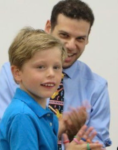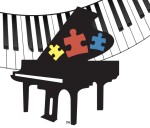Occupational Octaves: Revolutionizing Piano for Special Learners Part 2
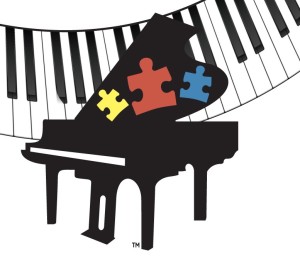 Hey friends, welcome back to the Occupational Octaves Column! Once again, my name is Lee Stockner and I am the creator, owner and president of Occupational Octaves Piano™, the first ever Special-Needs-User-Friendly piano curriculum & training program! This is the second part of my introductory blog, the first part of which I used to introduce the success of one of my longest tenured students, Alie. While Part 1 focused on what was different about Alie, his daily challenges and the incredible triumph of his musicianship, today I’d like to focus on how Alie’s experience at the piano is virtually the same as the experience of what we call “neuro-typical” learners, or those without a disorder/challenge. Today you will also meet my student Ruby and her Mom.
Hey friends, welcome back to the Occupational Octaves Column! Once again, my name is Lee Stockner and I am the creator, owner and president of Occupational Octaves Piano™, the first ever Special-Needs-User-Friendly piano curriculum & training program! This is the second part of my introductory blog, the first part of which I used to introduce the success of one of my longest tenured students, Alie. While Part 1 focused on what was different about Alie, his daily challenges and the incredible triumph of his musicianship, today I’d like to focus on how Alie’s experience at the piano is virtually the same as the experience of what we call “neuro-typical” learners, or those without a disorder/challenge. Today you will also meet my student Ruby and her Mom.
Before continuing I must note that this is a lengthy blog and after I’ve established the following ideas in detail, my future writings will be much shorter!
As a quick refresher, Alie is severely autistic. He cannot read or write, and is both nonverbal and hyperactive. Click here to read more about him. My goal in this blog is to show you how Alie and almost all of the Occupational Octaves Piano™ students are able to engage in the same cognitive gains that “neuro-typical” individuals do through the use of a Special-Needs-User-Friendly language of music. Before moving forward, I’d imagine many piano teachers/players reading the words ‘cognitive gain’ know the term, but might not exactly be sure how to define it. While this is not the time nor the place to get into a scientific definition, I can place the main points in the context of traditional piano pedagogy. Although the following portion actually has nothing to do with special needs, please bear with me as it will all connect together soon!
When people become “smarter and happier” from playing the piano and reading music, it is not a magical process. It is a labor of love that takes hard work, concentration and practice. While what we concentrate on and practice are songs that we call Fur Elise or Minuet in G, I focus on the smallest parts of the whole process that include not only the translation of a musical instruction, but also the mental and physical processes that all have to work in conjunction in order for anyone to perform. I’ve named this process the “Piano Circle of Cognitive Gain” and this is what it looks like:
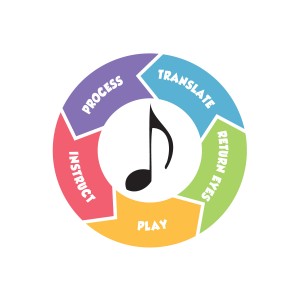
Numerous studies show that students engaged in reading music, especially those who play the piano, tend to be “smarter,” score better on exams and show overall better cognitive function. The examples are endless and there will be a future blog to address specific studies. While many may believe these positive products of musicianship come from reading the complex traditional language of musical notation, I believe that it’s the 5-steps of the Piano Circle of Cognitive Gain that lead to the positivity and that it’s not a matter of what language of music is being used, but instead how frequently and precisely the student can engage in the steps.
To the laymen’s eye, if watching the best pianist in the world read the most difficult piece of music ever written, the eye may see what appears to be a repeated two-step process. Read the note, play the note, then repeat – read the note, play the note, read the note, play the note, read the note, play the note…

Upon further review, I realized this was incorrect and that students were actually engaged in a 5-step repeated process, which is the aforementioned Piano Circle of Cognitive Gain. Here’s a quick glossary for these 5-steps, which any player who is properly reading music and playing a song is engaged in:
1 – Translate – Look at the symbol and identify it – ‘G, eighth note.’
2- Process – Locate the note, figure out which finger to use based on the current hand position or instruction on the page – ‘I have to push the G with my 3rd finger because I just played an F with my 2nd finger and then have to hold it for half a beat because it’s an eighth note.’
3 – Instruct – Send a neurological instruction from the brain to the hand/fingers which contains the information processed which was derived from the translation.
4 – Play – Using the correct note(s), finger(s), and beat(s), push down on the appropriate key, keeping the body in a strong position and not moving any extra parts of the body for any unnecessary reason.
5 – Return Eyes – Without hesitation or distraction, look back up to the music immediately to the exact note(s) needed to be read, and re-engage in the five steps.
While most teachers/players may not consciously consider these steps, virtually every time we read a note we are engaged in them and if we don’t engage in them repeatedly, correctly and in rhythm, the songs we play will fall apart! This is the process that the best player reading the most difficult song engages in and it’s also the process that a 5 year old playing Mary Had a Little Lamb uses. I’d recommend taking a moment now to review these ideas and really think about how you as a player engage in the Piano Circle of Cognitive Gain or how you might have been teaching students all along to engage without ever realizing it. This process is not my invention or creation, it is simply my observation of what already exists in the world of musicianship. So, finally.. what does this have to do with special learners?!
Special learners often lack the routes to the positive feelings and the cognitive improvements from many activities in life and I want to change that. I am best equipped to help through the piano but unfortunately many special learners are unable to engage in the first step of the Piano Circle of Cognitive Gain (translation of traditional music notation) and are therefore unable to engage in the entire process. Right??
Many special learners can’t read and/or comprehend traditional music notation but if they could, would they be able to engage in the other 4 steps? Would they be able to process the translation into an instruction, or send a neurological instruction from their brain to their finger(s), or properly return the eyes back to the music? When I set out to explore I came back with a resounding YES! This means that if we can just get past the step of translating the confusing, complex, black and white sheet music, a great variety of special learners can theoretically engage in the Piano Circle of Cognitive Gain (PCoCC), and its numerous benefits! My thought was if the music is written in a language that is foreign to the individual, I should write the same things in a language that the individual can read, which is exactly what I did with Lee Stockner’s Music Box Method™. While most music books are written in traditional music notation, Occupational Octaves Piano™ is written in Lee Stockner’s Music Box Method, which anyone who can match colors and letters should be able to use with great success! Here’s what happens when a Special Learner tries to read music using a Special-Needs-User-Friendly language of music – engagement in the PCoCG becomes not only possible, but fully functional.
When students can read music using a Special-Needs-User-Friendly language, they can immediately translate the colored letters which means they know exactly which note to push, which finger(s) to use and how long to hold for, just like a traditional player. (click or tap to view and zoom.)
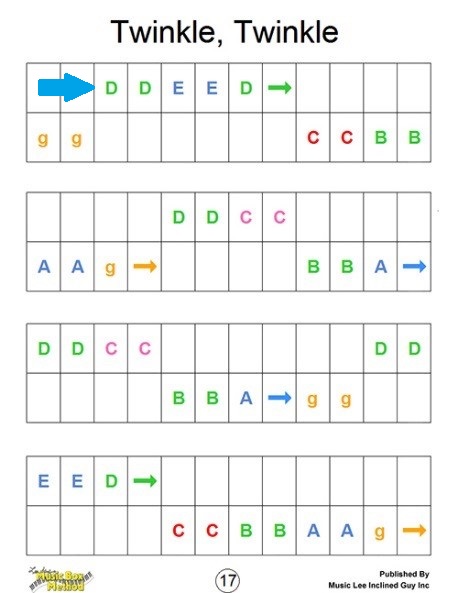
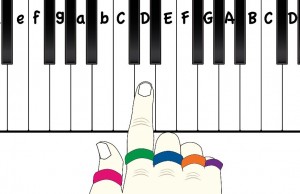
Once a student reads a green D, he or she can easily translate the instruction no differently than a neuro-typical individual reading traditional music, and then can engage in the steps that come next! I know it’s a long winded statement, but this is how the Special Learner can engage in the same process as a neuro-typical learner:
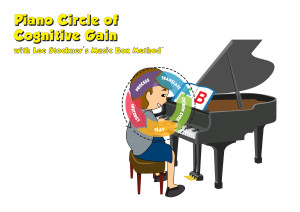
Below is a video of a student named Ruby. She is diagnosed with Autism and it has a severely negative impact on her life. She is virtually unable to engage in any normal activities. She has what I call an “irregisterable IQ” and according to her mom, doctors, therapists and other teachers, her level of intelligence is extremely low. Her ability to communicate can be considered minimal at best. When she came to me as a student, her mom was trying her last resort as all other options failed, miserably. I post this video so you can see Ruby’s engagement in the Piano Circle of Cognitive Gain. Just like you and me, she first translates a note, then processes it into an instruction, sends that instruction from her brain to her fingers, plays the notes and returns her eyes to the next note to continue. I believe that at some point, after going through this process thousands of times (on average a student engages in the Piano Circle of Cognitive Gain 40 times per page), a student becomes a musician. I think Ruby is a musician! This video begins with a conversation with Ruby’s mom, but feel free to fast forward past our chat by clicking on “Ruby’s Lesson” to see her engagement and musicianship!
If you read my previous blog and saw the video of Alie playing the National Anthem at C.J. Ramone’s Autism Benefit event, you’ll see now that the reason he’s such a successful player is that he’s engaged in the Piano Circle of Cognitive Gain. You can see both the positivity from musicianship and that he put in all the cognitive work a traditionally learning musician puts in to learn a song note for note, finger for finger and beat for beat. This is a tough idea for many in the music/music education world to swallow so please feel free to reach out with any questions about my program or Special Needs Music Education – Lee@OccupationalOctavesPiano.com. For today, I’ll leave you with a list of songs Alie and/or Ruby have played:
- Nutcracker March
- Jingle Bells
- Nocturne
- Alouette
- Ecossaise
- Hungarian Rhapsodie
- Morning
- Horn Call
- Pathetique Sonata
- Clementi’s Sonatina Op. 36 No. 1
- Mountain King
- Lichner’s Sonatina
- Hungarian Dance
- Bolshoi Bagatelle
- Mozart’s Air
- Countless others!……..
